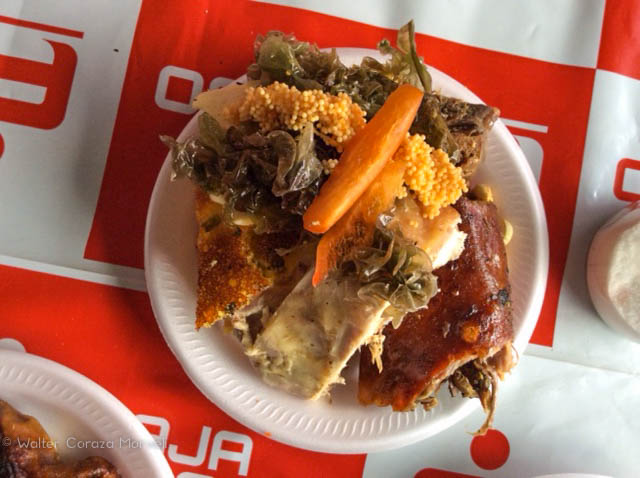Ideas on the Origin and Nature of Chiriuchu

Considered the iconic food of Cuzco, chiriuchu fascinates. It is not like ceviche, lomo saltado, or an arroz chaufa.
Its elaborateness comes less from the skill of cooking, although that is very important, than it does from combining a variety of foods together. It is not just any variety but is one that carries ties to an elaborate set of regions and meanings, from the sea coast, to valleys, to the high altiplano.
Chiriuchu is about bringing things together just as a mountain unites lots of different ecological zones into a single whole.
As such it reminds one of how, in Inca times, and even today, people would come to the capital of Cuzco for feasts bringing on their backs food from their homes and communities.

As a result, a feast would be about the union of foods from many places, although people would also be offered some of the sacrificial animals.

In the contemporary altiplano, there is a custom that reminds us of this. In Aymara it is called the apthapi. People come to a gathering or an event in the community. They lay down what they have brought, along with that of everyone else, on aguayos (in Aymara) or lliqllas (in Quechua) carrying cloths laid end to end.
People then serve themselves or, if they are guests, are served a little bit of everything that was brought and is contributed to the community meal.
Like fiambres, food carried into the fields for a meal while people eat, the apthapi is eaten cold. The food is not reheated. Instead there are small bowls of something to give it heat or seasoning, such as a bit of hot pepper ground into a sauce with onions. There might even be a little bit of white clay to season the cold food.

The chiriuchu, as something served cold and as a combination of offerings that remind one of lots of different regions, is similar to the apthapi. It also has strips of rocoto, or colorful hot pepper, on top to give that added bit of zing.
A friend, Juan Arréstegui, who is from the altiplano, the region of Juliaca in Puno and who has resided in Cusco for decades, suggested to me that chiriuchu might even originate in a custom like that of the apthapi.
Garcilaso talks about people bringing their food to feasts but he makes it sound as if they ate what they brought instead of sharing it.
As a result, Arréstegui’s thought raises an interesting idea, one that fits within customs and which would make even more sense out of the chiriucho’s importance. It is one which needs careful study in the archives to see if there is any evidence to substantiate it.





